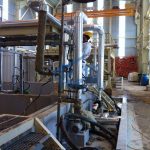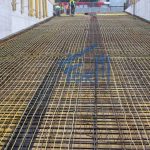Self-Regulating Heating Cables
Self-Regulating Resistance Cables
Heat trace cable is mostly used in the industrial field and it is the industrial definition of this term. Resistance cables, mostly in the industry, are originated from the frequently encountered need to protect gas and liquid fluids from freezing and to prevent heat loss or to heat them.
This need is met in every environment and business with accompanying hot water-steam pipes or electric heating cables.
In the last 50-60 years, the use of heating cables in industrial facilities for heating and heat tracing purposes has been constantly increasing compared to steam and hot water systems. This is mostly because of the reliability and very long life provided by modern heating cables. In addition, the electrical energy can be controlled very easily, and the heating cables do not require maintenance, which provides great savings in operating costs. More importantly, industrial facilities are able to operate without interruption in a fast and cost-effective way.
Heating cables are used in projects such as ramp heating, floor heating, snow ice prevention on the floor, roof gutter heating, and pipeline heating. Industrial pipeline heating comes first among the general heating cable application areas. The use of heating cables for pipeline heating and heat protection, which has been in use abroad for years, is increasing day by day. Industrial facilities established in cold climates face problems because of the cold weather.
In order for the dense material in the process lines not to solidify or crystallize, certain temperatures must be maintained. In heating cable applications, the process lines are kept at desired temperatures to ensure material fluidity. Freezing in the cooling lines is among the most common problems. If the system goes to the off position, the immobile water freezes. Freezing causes the system to stop, heating the pipeline with the heating cable. The heating cable ensures that the pipeline heating system runs smoothly.
- Hammam Heating
- Pipe Heating
- Tank Heating
- Road Heating
Three Types of Heating Cables are Used in Industrial Applications.
- Self-regulating Heating Cable
- Constant wattage Heating Cable
- Serial Resistance Heating Cable
Self-regulating Heating Cables
There are many types of cables in the heating cable industry. One of them is Self-regulating heating cables. The structure of this cable consists of two heating wires embedded in the heating matrix doped with carbon particles. When the temperature rises during operation, molecular expansion increases the distance between carbon particles. Resistance increases and output power decreases. As temperatures drop, this process reverses and output power increases. This physical property means that the heater wire will never overheat, can be mounted crosswise, stacked and operated without a temperature controller.
Constant wattage Heat Trace Cable
Each meter of resistance cables gives constant energy at every temperature. Due to their structure, the current-carrying and heat-generating parts are made up of different conductors. These cables can be cut and used in any desired length. They do not require a cold end, and their installation provides considerable convenience and low cost in all kinds of heat tracing applications, thanks to their single-end energy.
Constant Power Heating cables consist of a number of heating zones (length = contact spacing) and can be cut to length in sections of contact distance up to the required length. When cutting lengths, the heating circuit is cut to the next point of contact and this inactive part can be used with the cold end 80 cm to 100 cm. In the design phase, one contact gap length per planned heating circuit must be calculated additionally.
Serial Resistance Heating Cable
In Series Resistance Heating Cables, the part that carries energy and the part that produces heat is the same and is a chrome-nickel wire. These cables can be produced in different resistances. The resistances of these cables are directly proportional to their lengths, and the specific resistance can be cut at certain meters according to the desired power value.
There is a minimum length limitation that can be used to prevent excessive increase in current values that will pass over them. There are two types of serial resistance cable, single conductor and double conductor. It is produced in a way that phase connection is made from one end of single conductor cables and neutral connection from the other end. In double conductor series resistive cables, phase and neutral connections are made from one end.




